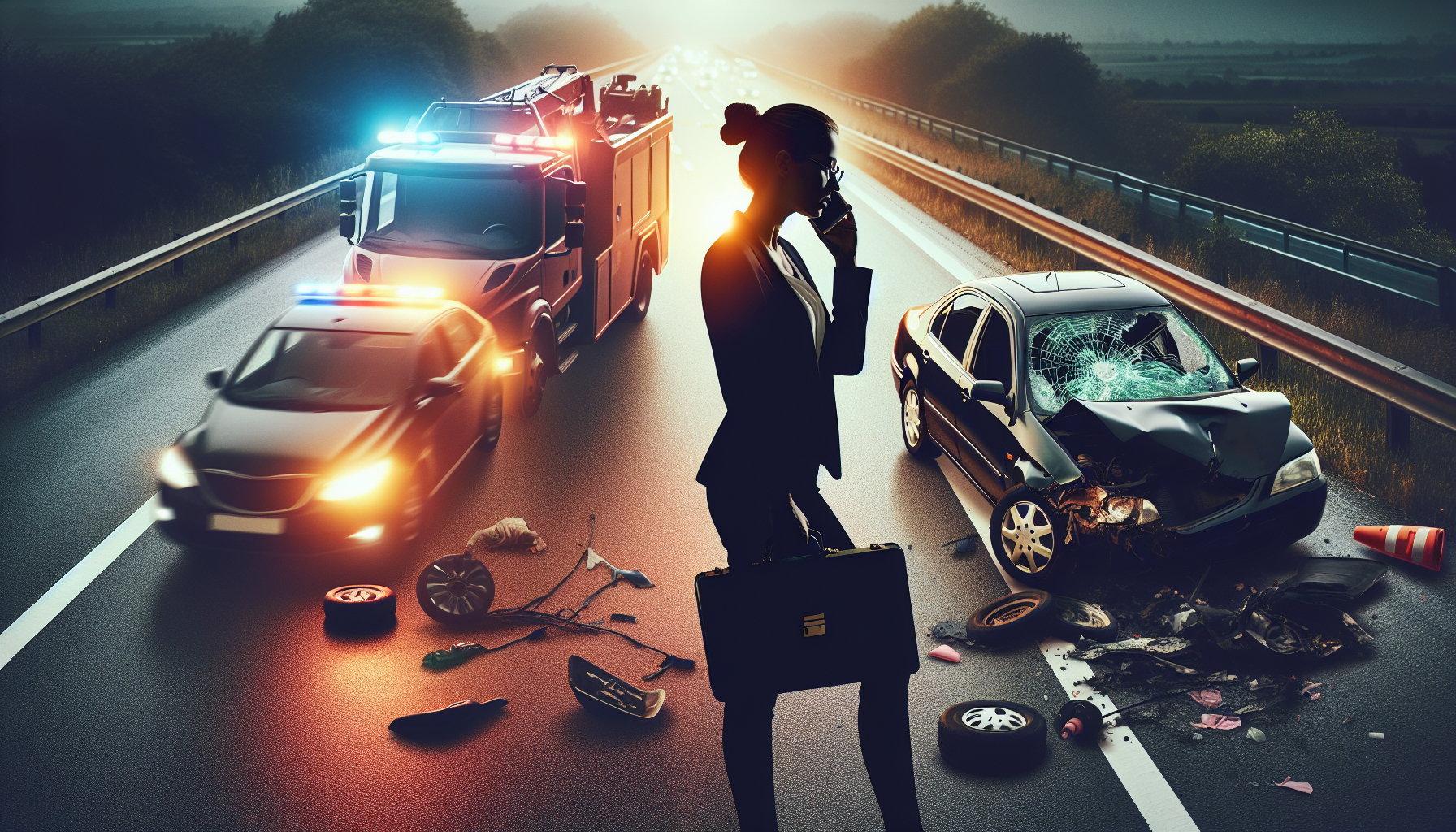
What to Do Immediately After a Car Wreck
After a car wreck, it’s crucial to prioritize safety, document the scene thoroughly, and report the incident to the necessary authorities and insurance companies immediately. The steps taken right after a car accident are pivotal in determining the outcome of insurance claims and any resulting legal matters, especially when issues like negligence or the statute of limitations come into play. This guide will navigate through the essential actions to undertake immediately following a car accident, from ensuring everyone’s safety to contacting car accident lawyers if needed. With these measures, individuals can safeguard their rights and potentially streamline the process with their insurance company, even when faced with emergencies that require a visit to the emergency room.
Check for Injuries and Ensure Safety
Prioritizing Health and Safety Post-Car Wreck
- Assess for Injuries: Immediately after a car wreck, it’s crucial to check yourself and others for injuries. Look for signs of internal injuries or concussions, which might not be immediately apparent.
- Seek Medical Attention: Even if you feel fine, underlying injuries might not be noticeable due to the shock and adrenaline. It’s essential to seek medical attention as soon as possible.
- Move to Safety: If it’s safe and you’re able to do so, move the vehicle away from oncoming traffic to prevent further accidents. Shift the car into “park” and turn on the hazard lights to alert other drivers.
- Call for Help: Dial 911 or the appropriate emergency number without delay. This ensures that medical and law enforcement assistance is dispatched to the scene promptly.
- Manage and Monitor Injuries: Following the wreck, establish a care routine to address and manage injuries. This might include following up with healthcare providers to restore function and reduce pain.
- Gradual Return to Activities: Based on recommendations from healthcare providers, slowly reintegrate into normal activities. This cautious approach helps prevent exacerbating any injuries.
- Safety Precautions: If the vehicle is inoperable, remain inside with seatbelts fastened. Use hazard lights, and if possible, set out cones, flares, or warning triangles to alert oncoming traffic.
- Symptom Awareness: Be aware of common injury symptoms such as headaches, neck or back pain, bruising, numbness, and psychological issues. These can manifest immediately or take time to appear due to adrenaline masking the pain.
By following these steps, individuals involved in a car wreck can ensure their safety and the safety of others, while also laying the groundwork for a smooth recovery process.
Report the Accident to Law Enforcement
Immediately after a car wreck, especially if there are injuries, it’s crucial to call the local police department. The officers will document the scene, collect information, and note any statutory violations, which is essential for any future claims or legal actions. Here’s a step-by-step guide on how to effectively report the accident to law enforcement:
- Dial 911: This should be your first step to ensure that law enforcement and emergency medical services are on their way if there are any injuries.
- Provide Detailed Information: When the police arrive, answer the officer’s questions thoroughly. Provide your driver’s license, vehicle registration, and insurance information. Stick to the facts of what happened during the accident.
- Obtain Officer Details: Ask for the names and badge numbers of the officers attending the scene. This information will be useful for future reference or if you need to obtain further details from the police report.
- Request a Police Report: A police report is crucial for insurance claims and legal matters. Ask for the incident report number and how you can obtain a copy of the police report for your records and to provide to your insurance company.
- If No Police Response: In some cases, especially in busy metropolitan areas, police may not respond to the scene. If this happens, you should collect as much information as possible at the scene. This includes taking pictures, obtaining witness statements, and looking for any video surveillance footage. You may need to file a police report yourself as soon as possible or file an accident report with the Department of Motor Vehicles (DMV).
- Legal Consultation: After handling the immediate aftermath with law enforcement, consider consulting with a personal injury lawyer. This can help you understand the potential legal ramifications and protect your rights.
Following these steps ensures that the accident is properly reported to law enforcement, which is a critical component in handling the aftermath of a car wreck effectively.
Exchange Information and Document the Scene
Exchanging information and documenting the scene after a car wreck is a critical step in ensuring all parties involved have the necessary details for insurance claims and legal matters. This guide provides a structured approach to collecting and documenting this essential information.
Collecting Driver and Vehicle Information
- Driver’s Details: Gather the other driver’s name, address, phone number, and insurance information, including the company name and policy number.
- Vehicle Information: Note down the car make, model, driver’s license number, and license plate number of all vehicles involved.
Documenting the Scene and Witness Information
- Photographs: Take comprehensive photos of the damage to all vehicles from multiple angles, ensuring to capture license plates, street signs, and road conditions.
- Witness Statements: If there are third-party witnesses, politely request their contact information. Their testimonies could provide valuable insights into the accident.
- Detailed Notes: Write down the location, time, weather conditions, and a brief description of how the accident occurred.
Maintaining Records
- Insurance and Legal Documentation: Keep a detailed record of all communications with your insurance company and any legal representatives. This documentation is crucial for navigating the post-accident processes efficiently.
Table: Essential Information to Collect at the Scene
| Information Type | Details to Collect |
|---|---|
| Driver’s Information | Name, address, phone number, insurance details |
| Vehicle Information | Make, model, license number, plate number |
| Scene Documentation | Photos of damage, street signs, road conditions |
| Witness Information | Names, contact details, statements |
| Accident Documentation | Location, time, weather conditions, accident overview |
This structured approach to exchanging information and documenting the scene will help ensure that all necessary details are accurately recorded, facilitating a smoother resolution process with insurance companies and legal bodies.
Contact Your Insurance Company
After a car wreck, it’s imperative to get in touch with your insurance provider as swiftly as possible. This step is crucial for initiating the claims process and ensuring that you are compensated for any damages, medical bills, and potential loss of income. Here’s a detailed guide on how to effectively communicate with your insurance company and what information you need to provide.
Step-by-Step Guide to Reporting an Accident to Your Insurance Company
- Notify Your Insurance Provider: As soon as it’s feasible, inform your insurance company about the accident to start the claims process. This initial contact can be made via phone, through their website, or even through a mobile app if your insurer offers one.
- Provide Essential Information: When reporting the accident, be ready to provide the insured driver’s full name, phone number, policy number, the policy’s start and end dates, the date and time of the accident, and the driver’s license and license plate numbers for all involved drivers. Also, offer a general description of the accident.
- Documentation Is Key: Keep detailed records of all vehicle repairs, medical expenses, and any loss of income. This documentation is vital for assessing and addressing the financial impact of the accident.
- Claims Adjuster Assignment: Once the claim is reported, the insurance company will assign a claims adjuster to your case. This professional will arrange for a car inspection and review all available evidence to determine the compensation amount.
- Understanding Your Coverage: It’s essential to know the type of insurance coverage you have, as this will determine if your policy covers property damage and bodily injury expenses resulting from the accident.
- Dealing with the At-Fault Driver’s Insurance: If the other driver was at fault, you should also report the wreck to their insurance company, as their policy should cover car repairs, medical bills, and potentially a rental car.
- Choosing a Repair Shop: While the insurance company might suggest body shops, remember that you have the right to choose any shop. The insurance company will provide a repair estimate, and if the actual costs are higher, the body shop will submit a new estimate for approval.
- Legal and Medical Consultation: Consider consulting with a personal injury lawyer to ensure you receive a fair settlement, especially for significant injuries. An attorney can help negotiate with insurance adjusters and pursue compensation for current and future medical bills, lost wages, and other damages.
Important Considerations When Dealing with Insurance Companies
- Report Within the Deadline: Every insurance company has its own deadline for reporting an accident. Make sure to file your claim within this period to avoid any negative consequences.
- Communicate Wisely: When discussing the accident with your insurance company, report your injury but wait until after seeing a doctor to provide details. Stick to the facts of the accident, and consult with an attorney before accepting any settlement offers.
- Resolution: The insurance company will conclude the investigation by either denying your claim or accepting it and issuing a settlement check. Consult with a personal injury lawyer before settling your injury claim to ensure the deal is fair.
By following these steps, you can navigate the post-accident process with your insurance company more efficiently, ensuring that you receive the compensation you deserve.
Conclusion
Navigating the aftermath of a car wreck requires prompt action and attention to detail, from ensuring everyone’s safety to dealing with law enforcement and insurance companies. Throughout this article, we have emphasized the critical steps individuals must take immediately following an accident, including checking for injuries, securing the scene, documenting evidence, and initiating the insurance claim process. These measures not only provide a foundation for a smoother recovery both physically and financially but also protect one’s legal rights.
The significance of these steps cannot be overstated, as they play a pivotal role in the resolution of any claims or legal issues that may arise. By adhering to the guidelines laid out, individuals can facilitate a more efficient and effective handling of the complex situation that follows a car wreck. It’s also clear that while the immediate aftermath of an accident is fraught with challenges, understanding the necessary actions to take can empower individuals to navigate these difficulties with confidence and clarity.
FAQs
1. What are the immediate actions to take right after a car accident occurs?
First and foremost, assess if anyone is injured and needs medical attention, including yourself. Safety is the priority, so ensure that all individuals involved are checked for injuries. If it’s safe to do so, move vehicles to the side of the road to avoid further incidents.
2. What steps should you follow right after a car crash?
Immediately after a car crash, prioritize calling 911 if there are any injuries. It’s important to also alert the police to the accident. Collect and exchange essential information such as names, addresses, phone numbers, driver’s license numbers, vehicle identification numbers, and license plate numbers from all drivers involved. Additionally, gather contact details of any passengers and witnesses present.
3. What is the recommended procedure to handle a car accident effectively?
Here are six essential steps to follow after a car accident:
- Check for any injuries among all involved and provide immediate assistance.
- Move to a safe location to avoid any further accidents.
- Contact emergency services by calling 911.
- Exchange contact and insurance information with other drivers involved.
- Document the scene by taking photos and notes of any damages and the environment.
- Consider contacting a lawyer to discuss any legal steps or claims.
4. What should be your initial reaction if involved in a vehicle crash?
The initial step after being involved in a vehicle crash is to check for injuries within your own vehicle and then with others involved in the accident. After ensuring everyone’s safety and attending to any immediate medical needs, if the situation allows, move the vehicles to a safer location off the road to prevent any further hazards.


